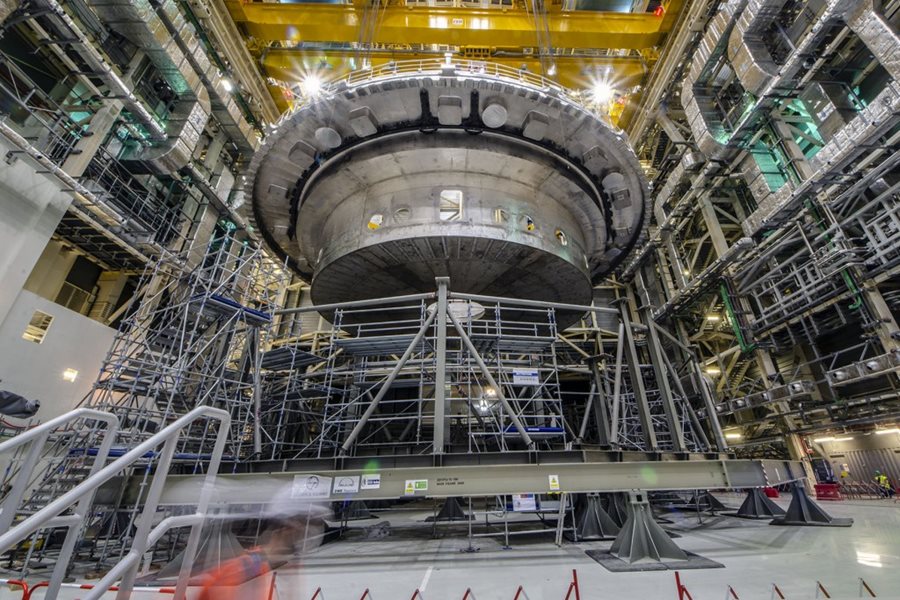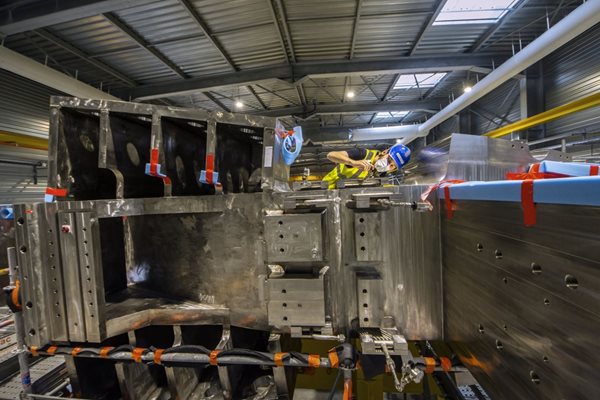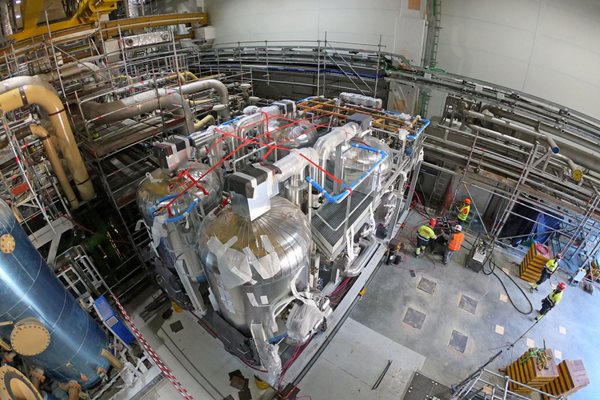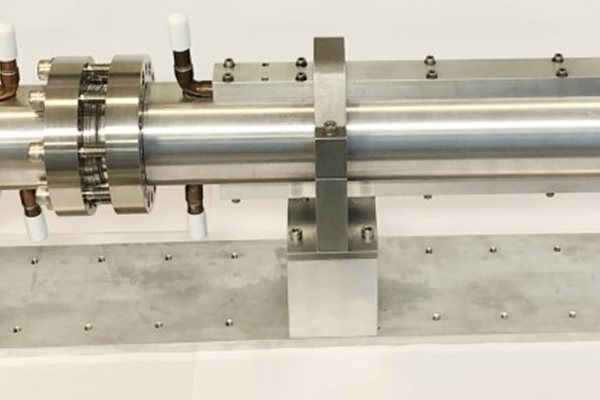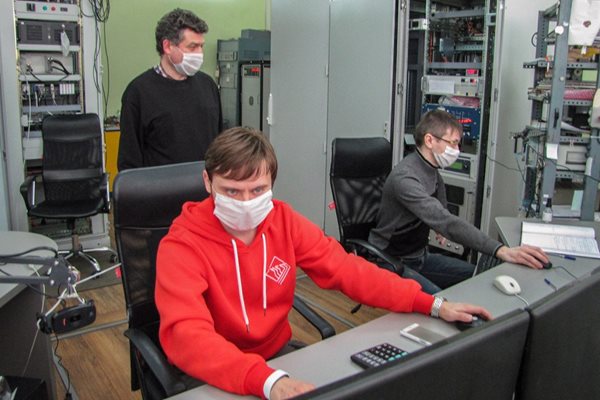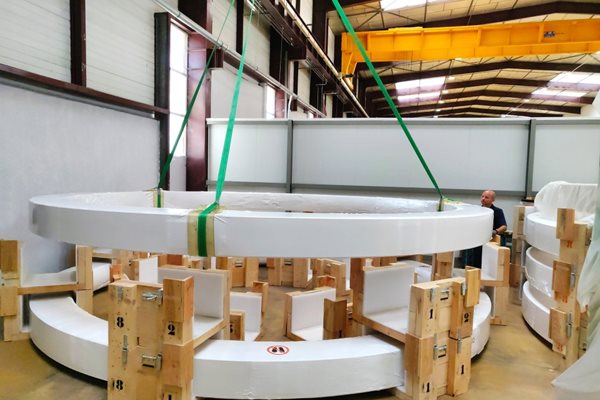
you're currently reading the news digest published from 25 May 2020 to 02 Jun 2020
featured6
video1
press21
featured
Cryostat base insertion | "A moment that will live in our memories"
In the closing scene of the 1977 movie Close Encounters of the Third Kind, an alien spaceship hovers above an anxious and awestruck crowd of scientists and engineers. The ship looks like a giant soup bowl, with lights filtering through openings in its hull. As the ship slowly descends to the ground, there's an intense feeling of wonder and expectation among onlookers—a sense that a new era is dawning upon humankind. On Tuesday 26 May, as the soup-bowl-shaped base of the ITER cryostat was gradually lifted from its frame, carried across the Assembly Hall to the Tokamak Building and eventually lowered into the Tokamak assembly pit, the Spielberg blockbuster was in everyone's mind. Not only did the component's shape bring back images of the alien ship, it also conveyed a similar significance. With the installation of the first major machine element, humankind was taking a decisive step toward the realization of fusion energy. And by providing clean, safe and unlimited energy, fusion has the potential to alter the course of civilization. Tuesday's operation in the machine assembly theatre marked the culmination of a ten-year effort to design, manufacture, deliver, assemble and weld one of the most crucial components of the ITER machine—the 30-metre-high, 30-metre-in-diameter ITER cryostat (of which the base is only one part)—which will act as a thermos, insulating the magnetic system at cryogenic temperature from the outside environment. Procured by India, manufactured in segments by Larsen & Toubro Ltd at its Hazira factory, the cryostat is assembled and welded on site under the supervision of the Indian Domestic Agency. The elements for the base section were delivered to ITER in December 2015 and the 1,250-tonne component was finalized in July of last year. Taking over from the Indian Domestic Agency, the ITER Organization then proceeded with "pre-assembly work' before moving the component into the Assembly Hall one month ago. And there it stood for a little more than one month, a giant among the other ITER giants. Spielberg's movie doesn't say how long, and how carefully, the alien ship's crew tested and rehearsed procedures before delicately landing it. For the cryostat base, these preparatory steps took the better part of one week. The base had been assembled and welded inside a sturdy support frame, acting as a rigid exoskeleton. For the first time, the component would be lifted out of its steel cradle and it was of crucial importance to verify that the deformation incurred would remain within tolerances. However thick the steel plates, a component as large and as heavy as the cryostat base becomes slightly flexible once suspended in the air. Despite carefully balancing the load supported by each of the crane's four spreader beams, deflections are inevitable and acceptable as long as they remain within tolerances. Incremental lifts, first a few centimetres, then a few metres above ground, allowed for the fine-tuning of the crane systems. These movements were interrupted at regular intervals to perform metrology surveys, ensuring that reality reflected what had been planned and modelled over the years. And it did. By Tuesday morning, all the experts involved were confident enough to launch the actual operation—a 110-metre-long journey from one end of the building to the other, passing above and over the two 20-metre-high sector sub-assembly tools and eventually reaching the circular opening of the machine assembly pit. There, one of the most delicate phases of the operation slowly unfolded as the cryostat base descended into the deep concrete cylinder, almost brushing its inner walls, to be positioned within millimetre accuracy into its support system. At the start of the operation, ITER Director-General Bernard Bigot had stressed the unique importance of the moment and expressed his confidence in the operation's success. 'The coming moments will stand out in the minds and memories of us all,' he said. 'What you will accomplish today, as a team, is something that has never been done before in history—and although you have rehearsed it many times, it will be a first-of-a-kind operation. We trust the engineering calculations, strategy and control. We trust the materials science. We trust the metrology. But my confidence today is because I trust you to work as one committed and highly professional team, convinced as we all are that failure is not an option.' And fail it did not. By Wednesday afternoon, the first and heaviest component of the ITER machine was positioned at its final altitude a few centimetres above the hydraulic jacks that will support its weight until final metrology and adjustments are performed and the load can be transferred to the cryostat support bearings (more details in the photo gallery below). With this spectacular achievement, a new chapter has opened in the long history of ITER. Click here to view a video of the operation.
Toroidal field coils | Finishing touches on site
Between the time a toroidal field coil is delivered to ITER and the moment it is ready to enter the pre-assembly process, certain tasks must be performed: the welds in the helium piping need to be leak-tested and additional handling and pre-assembly equipment must be added. Two toroidal field coils, TF9 from Europe and TF12 from Japan, were recently delivered to ITER. A third coil, TF13, sailed from Kobe harbour in Japan on 15 May 2020 and is expected reach France in mid-June. On each component, preparatory work must be accomplished before the coils are transferred to the upending tool in the Assembly Hall to be lifted to vertical and installed on the wings of the sub-sector assembly tools. The first toroidal field coil 'pair'—TF12 and TF13—will be associated with vacuum vessel sector # 6 (which Korea recently finalized) and thermal shield panels to form the first of nine 'sector sub-assemblies' to be descended into the Tokamak assembly pit.
Cryogenics | As dry as He can get
Before it gets processed in the cold boxes of the ITER cryoplant, gaseous helium need to be perfectly dry—and this means removing every single water molecule that it might contain. This operation is tasked to the massive 'helium dryer' that was installed on 27 May in ITER's 'cold factory.' Manufactured by Air Liquide under a contract from the European Domestic Agency Fusion for Energy, the 56-tonne component is one of the very last elements to be installed in the ITER cryoplant. Click here to view a video of helium dryer installation.
Electron cyclotron transmission lines | Design phase ends
US ITER is ready to start manufacturing high-power microwave transmission lines for the electron cyclotron resonance heating system. After several years of design analysis, prototyping and strict attention to complex structural demands, the US ITER electron cyclotron heating line team completed a final design review of transmission lines for the microwave plasma heating system. The team is now preparing for initial fabrication contracts. 'Our thermal mechanical analysis at the system and component level were top notch,' said US ITER team lead Kurt Vetter. 'The prototyping validated that we could achieve tolerances and be aligned with the analyses of the transmission line components. We clearly showed this during the review.' In a first for US ITER, the final design review was completed entirely remotely, a necessity due to travel restrictions related to COVID-19. Over 50 people from across the global ITER fusion project participated in the review. The microwave heating system includes over 4 km of transmission lines, plus components such as switches, bends, couplings and bellows. The electron cyclotron system will provide 20 MW of heating power to the ITER plasma. A major challenge of the design is assuring that minimal power losses, or microwave mode changes, occur along the length of the transmission lines. The ITER performance requirements have never before been achieved on transmission lines of this length or power. Senior project engineer Greg Hanson noted that there were multiple areas of improvement as the team prepared the final design, including demonstration that a 50 mm diameter transmission line was optimum for microwave performance. As the team moves into fabrication, a major early effort is focused on establishing a reliable manufacturing process for the transmission lines, which will mostly be produced in three-metre lengths. Inside the aluminium transmission line, finely specified corrugations will serve as guides for the microwaves to move along the lines. The team also established that structural supports for the lengthy system are a critical part of optimizing transmission line performance. The transmission lines traverse three buildings at the ITER facility—each one with its own foundations and seismic requirements. 'Because of the sensitivity of electron cyclotron transmission line performance to additional components, which can add gaps to the line, we had to find a very specific balance to locate additional couplings or bellows without degrading microwave power modes,' said Zach Wolfe, a project engineer who led the structural design and analysis effort. ITER will rely on three forms of plasma heating: neutral beams for bulk heat, with supplemental resonant heating by the ion cyclotron system, and electron cyclotron heating for depositing heat in specific locations during all phases of a plasma pulse. Through a switching system, the electron cyclotron transmission lines can direct power to upper launchers, in order to target power deposition, or to equatorial launchers for general plasma current drive or even counter-current drive. The system can also be used to accelerate or decelerate plasma current. The total electron cyclotron heating system is a deeply international effort, as the European Union, India, Russia, and Japan are also contributing components, including power supplies, gyrotrons (see related article in this issue), and launchers for the system. See the original article on the US ITER website.
Gyrotrons | Russia completes four
Gyrotrons (from the Greek 'gyro' (circle) and 'tron' (abstracted from electron) are the energy-generating devices of the electron cyclotron resonance heating system. Russia will supply eight of these devices in total, or one-third of the total installed capacity on the ITER machine. Late May, the fourth device in the series successfully passed factory acceptance testing. From 25 May to 2 June, factory acceptance testing performed at GYCOM Ltd. (Nizhny Novgorod) demonstrated that, as with the first three in the series, the fourth gyrotron manufactured in Russia fully complies with the specifications of the ITER Organization. The tests—which were held in advance of the original calendar—were attended remotely by representatives of ITER Russia and the ITER Organization. ITER will rely on electron cyclotron resonance heating to initiate each plasma shot, contribute 20 MW of heating power to the plasma, and suppress certain types of plasma instabilities. The demanding power and frequency requirements for the system (1 MW at 170 GHz for 1000 seconds) led to an ambitious, multi-decade development program in which Russia (through the Institute of Applied Physics and GYCOM Ltd), Japan, Europe and the United States—all contributing parties to the ITER electron cyclotron system—were closely involved. Since the signature of Procurement Arrangements with the ITER Organization, the gyrotron programs have gone through lengthy prototyping, review and test phases. Eight gyrotron units need to be installed for ITER's First Plasma—four from Russia and four from Japan. (Sixteen other units will be installed after First Plasma.) Delivery of the first gyrotron pair from Russia is scheduled for mid-2021.
Pre-compression rings | Six packed and stacked
In a factory not far from ITER, French equipment manufacturer CNIM (Toulon) is working under a contract with Europe's Fusion for Energy to manufacture a set of nine composite rings. These high-tech components—with exceptional tensile strength—will have an important role to play in protecting ITER's toroidal field coils. During the estimated 30,000 pulses of the ITER machine, the ITER toroidal field coils and coil structures will be subjected to huge electromagnetic forces, on the order of several hundred meganewtons (MN). Caused by electromagnetic interaction between the toroidal field coil current and the magnetic field generated by the poloidal field coils, these out-of-plane forces will cause stress to the toroidal field coils and, over time, fatigue. Six pre-compression rings—three at the top and three at the bottom—will hold tightly to the coils with a radial force of 7,000 tonnes per coil, pulling the coils into contact and reducing toroidal tension in the outercoil structures. Three other composite rings will be manufactured as spares. Six pre-compression rings have been handed over to the ITER Organization and three others are in fabrication at CNIM. Read the full story on the Fusion for Energy website.
